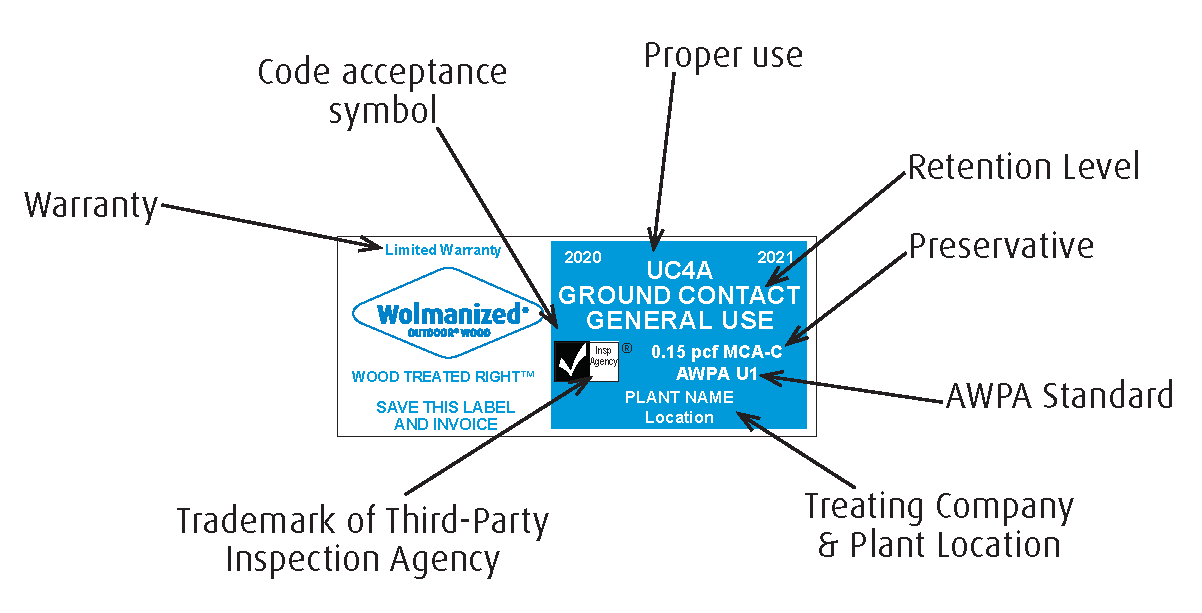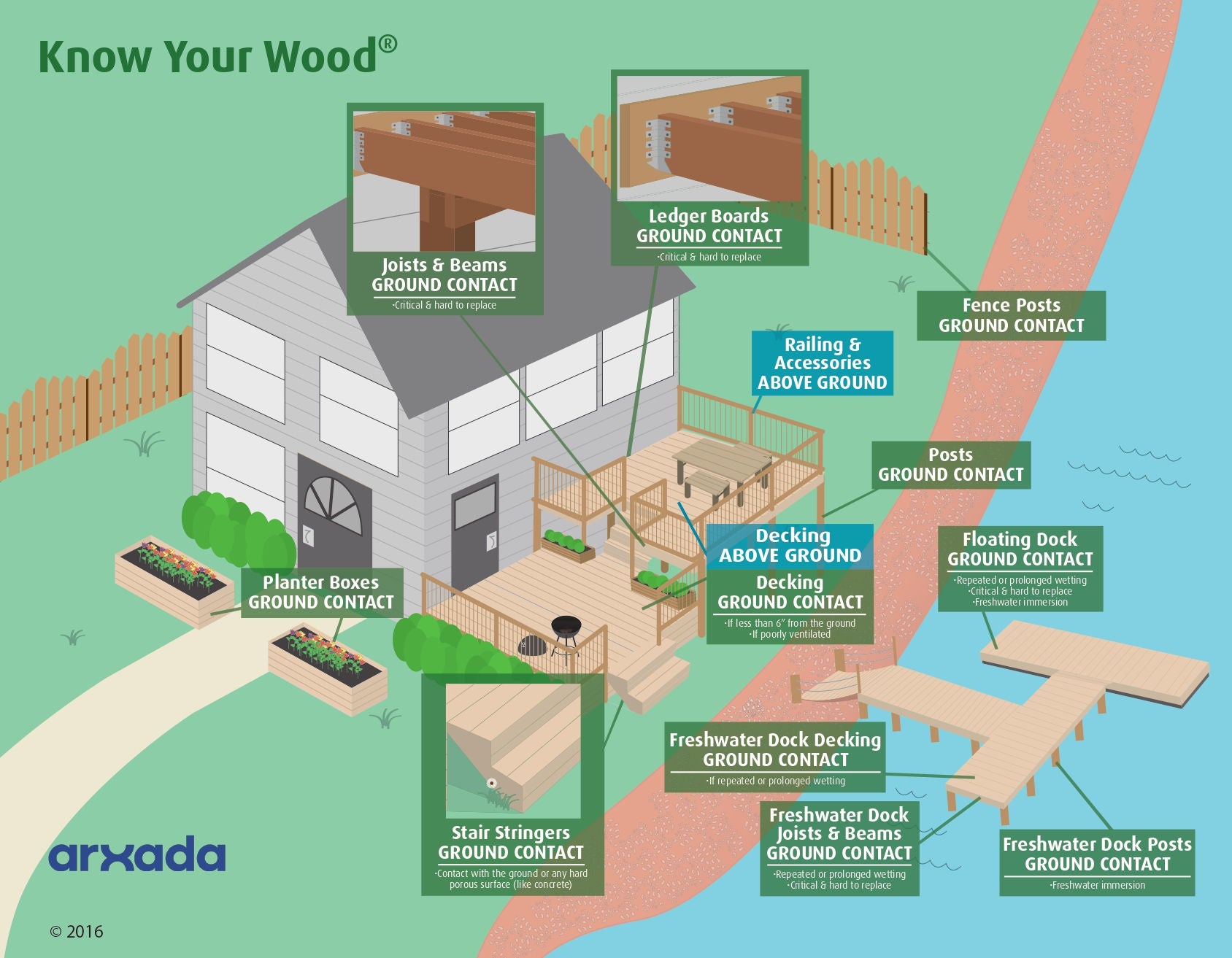Proper Use/Installation
Learn about the proper applications for your treated wood as well as installation/fastener tips
Before You Start Your Build Here are Some Considerations
When planning your deck, consider the safety of your family and guests. A deck is an uncovered, outdoor structural floor system that is expected to endure changing weather and carry significant loads over many years. Careful material selection, design, installation, plus periodic inspection and
maintenance are keys to long-term performance and structural stability.
Once you have decided on the basic size, shape, and location of your deck, check local building codes to find out if there are restrictions as to height and size within your subdivision or community. Contact your local building department for any specific requirements and guidelines they may have, and find out if a building permit is required before you build your deck.
NOTE: if you are located in Western states and are planning to build a deck in a designated wildfire area, you will need to consult the Wildland Urban Interface Code for building requirements.
Selecting Your Materials
Over the past few years, many alternative materials have been introduced for deck construction. The primary deck material, however, is pressure-treated wood.
Treated wood, sold in nearly every lumber outlet in North America, is chosen by contractors and do-it-yourselfers for a variety of reasons:
• It comes from a plentiful and renewable resource
• Its resistance to termites and rot is well established
• It is usually the most economical choice
• It has a naturally beautiful appearance
• It is flexible and easy to work with using common tools
• It is easy and inexpensive to maintain
Wolmanized® Outdoor® Wood, is a trusted brand, tough enough to stand up to termites and fungal decay, and versatile enough to be used in all types of natural environments. It combines the natural beauty of real wood with the most popular, widely accepted preservative and a limited warranty against termites and fungal decay. If you are seeking wood with a metal-free preservative for above ground uses, consider Wolmanized EraWood® lumber.
There are other additional features available, including kiln-dried wood and treated wood with water repellent. These improve performance and may decrease maintenance requirements. Once you draw up your basic plan, take it to a home center or hardware store, and they can estimate the amount of materials you will need.
Be sure to check the labels to get the wood that is properly treated for your intended use. If the material you need is not available, check with the professional desk about special ordering.
Check the Labels
When you or your contractor buy Wolmanized® Outdoor® Wood, be sure to check the end tag stapled of the end of the wood. Each piece is identified for a specific use. This information will help you decide the correct material to buy for each part of your outdoor project.
IMPORTANT: Wood is treated with different amounts of preservative for specific applications. The label will designate Above Ground, Ground Contact or Ground Contact Heavy Duty classifications.
However, there are some cases where wood used above the ground should be treated to Ground Contact. The label will also refer to either AWPA U1 or ICC ESR 1721 which indicate the product has been produced and inspected to meet accepted requirements.

Choose the Right Type of Pressure Treated Wood for Your Application
How to Properly Choose Treated Wood
To obtain the maximum performance out of your treated wood for any outdoor project, you need to choose material that is appropriate for the conditions in which it will be used. Each piece of treated wood has an end tag that lets you know if the wood is meant for Above Ground, Ground Contact, or Heavy Duty Ground Contact applications. These end use descriptions refer to the types of conditions in which the wood is intended to perform. Below are guidelines on the meaning of those end use descriptions and the best practices in the selection and use of treated wood. All treated wood, regardless of preservative, that is used in residential and commercial applications should be selected and used in accordance with these guidelines. If the right material is not available in your store, ask about special ordering.
Remember, if your project is in contact with the ground or fresh water or built in a manner that does not allow the wood to easily dry, Ground Contact treated wood must be used.
Tips to Properly Install Your Deck Boards
• Separate deck boards to allow for expansion and contraction. If heavy and wet, separate boards no more than 1/16” as some shrinkage will occur. If light and dry, separate boards about 1/8” to allow for swelling.
• Shorter spans between joists will help to minimize warping and twisting of deck boards as they dry.
• Avoid designs with long cantilevers unsecured at one end; check with your local building department on maximum cantilever permitted.
• Lumber wider than six inches should not be used as a flat surface. Wide, flat boards are subject to ponding of rain water, which can lead to cupping problems.
• Place boards bark side up to help shed water. They will also be more likely to have treated sapwood on the exposed face.
• Make sure there is good under-deck ventilation for above-ground treated wood, allowing airflow around the entire deck.
• All material treated for above-ground use must be off the ground where it can dry easily and be free of leaves or other debris. If not, use wood treated to Ground Contact.
• All joists and beams must be treated to at least Ground Contact.
• Proper flashing or spacers should be used between all adjacent structures and the deck.
• If a board is bowed, install it with the crown up. Gravity and the weight of people and furniture will flatten it. Or, if a board has a slight bend to it, it sometimes can be straightened as it is screwed or nailed in place.
Fasteners
Photos to use (Called: 4_Proper Use and Installation_fasteners_sm and 4_Proper Use and Installation_fastener screwed in_sm)
• Screws take longer to drive than nails, but hold boards more securely and will allow for easier removal if necessary.
• Use 3 1/2” long nails on nominal two-inch decking and 3” nails for 5/4” decking. Use two nails across a 2 x 4 and three across a 2 x 6. Drive nails at a slight angle toward each other.
• To reduce splitting when using nails, especially near the ends of boards, drill a pilot hole about three quarters the diameter of the nail. For dense or brittle wood, grind sharpness from nails or blunt the points by striking them carefully with a hammer.
Wolmanized® Outdoor® Wood
Hot-dipped galvanized fasteners (meeting ASTM A 153) and connectors (ASTM A 653 Class G185 sheet), or better, are recommended. Fasteners not meeting or exceeding these requirements could result in premature failures and degradation of fasteners and treated wood. Aluminum flashing (3015 or similar alloy) may be used in contact with micronized copper azole treated wood in interior or exterior, above ground applications that are damp or intermittently wet. For dissolved copper azole preservative treated wood or whenever treated wood is subject to immersion or frequent or prolonged wetting, factory coated aluminum or an insulating moisture resistant barrier should be used between the treated wood and the aluminum. See the end tag for type of treatment (CA-C indicates dissolved copper azole and MCA indicates micronized copper azole).
Wolmanized EraWood® Lumber
Moisture, salt, and other agents can cause metal corrosion, but Wolmanized EraWood® lumber is no more corrosive than untreated wood. Check with your hardware manufacturer regarding specific uses. For those projects needing building code compliance, you can use hardware with the minimum protection permitted by codes and local regulations. Aluminum can also be used in direct contact with this wood.
End Cuts
For added protection, it is imperative to coat end cuts during construction.
• Liberally coat all cut ends, holes, or other intrusions into the wood with a suitable wood preservative product containing a minimum of 0.675% copper as oxine copper (copper-8 or copper-8-quinolinolate) or 1% copper as copper naphthenate.
• Orient supporting posts so that original factory treated ends are in contact with the ground. Trim the top ends as needed and cover them with post caps or cut them at angles to shed water and treat with a brush-on preservative.
